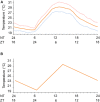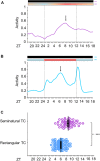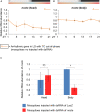The Summer Is Coming: nocte and timeless Genes Are Influenced by Temperature Cycles and May Affect Aedes aegypti Locomotor Activity
- PMID: 33424639
- PMCID: PMC7786104
- DOI: 10.3389/fphys.2020.614722
The Summer Is Coming: nocte and timeless Genes Are Influenced by Temperature Cycles and May Affect Aedes aegypti Locomotor Activity
Abstract
Mosquitoes exhibit activity rhythms, crucial for the transmission of pathogens, under the control of a circadian clock. Aedes aegypti is one of the world's leading vectors. For decades, several studies have linked the rise in ambient temperature with the increase in their activity. Here, we identify candidate genes whose expression is influenced by temperature cycles and may affect Aedes locomotor activity. We observed that timeless completely lost its rhythmic expression in light/dark, with out-of-phase temperature cycles, and by RNAi mediated knockdown of nocte, an important gene for Drosophila circadian synchronization by temperature cycles. Thus, timeless and nocte are important genes for synchronization by temperature cycles in Aedes aegypti. To reinforce our findings, we simulated in the laboratory the gradual temperature fluctuations that were as close as possible to daily temperature variations in Brazil. We observed that the activity and the expression of the molecular circadian clock of Ae. aegypti differs significantly from that of mosquitoes subjected to constant or rectangular abrupt changes in temperature. We suggest that for understanding the circadian behavior of Aedes with possible implications for intervention strategies, the seminatural paradigm needs to replace the traditional laboratory study.
Keywords: Aedes aegypti; circadian gene expression; circadian rhythms; clock genes; seminatural cycles; temperature cycles.
Copyright © 2020 Teles-de-Freitas, Rivas, Peixoto and Bruno.
Conflict of interest statement
The authors declare that the research was conducted in the absence of any commercial or financial relationships that could be construed as a potential conflict of interest.
Figures










Similar articles
-
nocte Is Required for Integrating Light and Temperature Inputs in Circadian Clock Neurons of Drosophila.Curr Biol. 2018 May 21;28(10):1595-1605.e3. doi: 10.1016/j.cub.2018.04.001. Epub 2018 May 10. Curr Biol. 2018. PMID: 29754901
-
Off with their heads: analysis of the circadian clock genes expression in the body of Aedes aegypti.Chronobiol Int. 2021 Jul;38(7):994-1001. doi: 10.1080/07420528.2021.1903030. Epub 2021 Mar 26. Chronobiol Int. 2021. PMID: 33771062
-
Cloning and daily expression of the timeless gene in Aedes aegypti (Diptera:Culicidae).Insect Biochem Mol Biol. 2006 Nov;36(11):878-84. doi: 10.1016/j.ibmb.2006.08.008. Epub 2006 Sep 14. Insect Biochem Mol Biol. 2006. PMID: 17046601
-
Genetics and molecular biology of rhythms in Drosophila and other insects.Adv Genet. 2003;48:1-280. doi: 10.1016/s0065-2660(03)48000-0. Adv Genet. 2003. PMID: 12593455 Review.
-
Temperature effect on entrainment, phase shifting, and amplitude of circadian clocks and its molecular bases.Chronobiol Int. 2002 Sep;19(5):807-64. doi: 10.1081/cbi-120014569. Chronobiol Int. 2002. PMID: 12405549 Review.
Cited by
-
Circadian regulation of dengue virus transmission and replication: insights into vector activity and viral dynamics.Front Cell Infect Microbiol. 2024 Sep 30;14:1482042. doi: 10.3389/fcimb.2024.1482042. eCollection 2024. Front Cell Infect Microbiol. 2024. PMID: 39403205 Free PMC article. Review.
-
Males of Aedes aegypti show different clock gene expression profiles in the presence of conspecific females.Parasit Vectors. 2022 Oct 18;15(1):374. doi: 10.1186/s13071-022-05529-8. Parasit Vectors. 2022. PMID: 36258200 Free PMC article.
-
Intra-species quantification reveals differences in activity and sleep levels in the yellow fever mosquito, Aedes aegypti.Med Vet Entomol. 2024 Dec;38(4):482-494. doi: 10.1111/mve.12747. Epub 2024 Sep 19. Med Vet Entomol. 2024. PMID: 39300685 Free PMC article.
-
Light and dark cycles modify the expression of clock genes in the ovaries of Aedes aegypti in a noncircadian manner.PLoS One. 2023 Oct 19;18(10):e0287237. doi: 10.1371/journal.pone.0287237. eCollection 2023. PLoS One. 2023. PMID: 37856474 Free PMC article.
-
Estimation of population age structure, daily survival rates, and potential to support dengue virus transmission for Florida Keys Aedes aegypti via transcriptional profiling.PLoS Negl Trop Dis. 2024 Aug 13;18(8):e0012350. doi: 10.1371/journal.pntd.0012350. eCollection 2024 Aug. PLoS Negl Trop Dis. 2024. PMID: 39137188 Free PMC article.
References
-
- Clements A. N. (1999). The Biology of Mosquitoes Vol. 2: Sensory Reception and Behaviour. New York: CABI Publishing.
LinkOut - more resources
Full Text Sources

